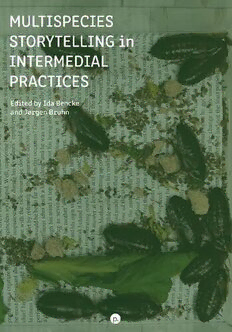
Multispecies Storytelling in Intermedial Practices PDF
Preview Multispecies Storytelling in Intermedial Practices
Multispecies Storytelling in Intermedial Practices Before you start to read this book, take this moment to think about making a donation to punctum books, an independent non-profit press, @ https://punctumbooks.com/support/ If you’re reading the e-book, you can click on the image below to go directly to our donations site. Any amount, no matter the size, is appreciated and will help us to keep our ship of fools afloat. Contri- butions from dedicated readers will also help us to keep our commons open and to cultivate new work that can’t find a welcoming port elsewhere. Our ad- venture is not possible without your support. Vive la Open Access. Fig. 1. Hieronymus Bosch, Ship of Fools (1490–1500) Multispecies Storytelling in Intermedial Practices. Copyright © 2022 by the editors and authors. This work carries a Creative Commons BY-NC-SA 4.0 International license, which means that you are free to copy and redistribute the material in any medium or format, and you may also remix, transform and build upon the material, as long as you clearly attribute the work to the authors (but not in a way that suggests the authors or punctum books endorses you and your work), you do not use this work for commercial gain in any form whatsoever, and that for any remixing and transformation, you distribute your rebuild under the same license. http://creativecommons.org/licenses/by-nc-sa/4.0/ First published in 2022 by punctum books, Earth, Milky Way. https://punctumbooks.com ISBN-13: 978-1-68571-022-4 (print) ISBN-13: 978-1-68571-023-1 (ePDF) doi: 10.53288/0338.1.00 lccn: 2022932942 Library of Congress Cataloging Data is available from the Library of Congress Book design: Vincent W.J. van Gerven Oei Cover photograph: Adam Dickinson punctumbooks spontaneous acts of scholarly combustion MULTISPECIES STORYTELLING in INTERMEDIAL PRACTICES Edited by Ida Bencke and Jørgen Bruhn Contents Introduction Ida Bencke and Jørgen Bruhn · 9 1. Politics of Terristories Vinciane Despret · 21 2. Secretome Perpetua Karin Bolender · 33 3. Tales of a Modern Parrot: Living Entangled Lives in an Interspecies Art Collective Hörner/Antlfinger · 49 4. The Laudable Cow: Poetics of Human/Cattle Relationships Emily McGiffin · 77 5. The Forest of Life: The Representation of the “Tree of Life” Metaphor across Media Péter Kristóf Makai · 97 6. The Plant-story? Listening and Multispecies Storytelling Fröydi Laszlo · 121 7. Arrangements for an African Anthropocene: Multispecies Storytelling at the Adderley Street Flower Market in Cape Town Melanie Boehi · 151 8. “You have to learn the language of how to communicate with the plants” and Other Selva Stories Kristina Van Dexter · 175 9. The Anti Menagerie: Fictions for Interrogating the Supremacy of World-shaping Violence Cassandra Troyan and Helen V. Pritchard · 189 10. #FEELSWeoutheregettinthisbread Gillian Wylde · 215 11. Learning from the Lake Katie Lawson · 225 12. Lagomorph Lessons: Feminist Methods for Environmental Sensing and Sensemaking Maya Livio · 237 13. The Blattarians Adam Dickinson · 255 14. WERT: Interspecies Weaving and Becoming Carol Padberg · 267 15. Creating Distance or Proximity? How Wild Lives Are Told through Remote Camera Viewing Elizabeth Vander Meer · 279 16. Dancing Is an Ecosystem Service, and So Is Being Trans Loup Rivière · 303 Contributor Biographies · 313 Introduction Ida Bencke and Jørgen Bruhn My multispecies storytelling is about recuperation in complex histories that are as full of dying as living, as full of endings, even genocides, as beginnings. In the face of unrelenting histori- cally specific surplus suffering in companion species knottings, I am not interested in reconciliation or restoration, but I am deeply committed to the more modest possibilities of partial recupera- tion and getting on together. Call that staying with the trouble. — Donna Haraway, Staying with the Trouble There are many kinds of life, said Spike [a robot], mild- ly. Humans always assumed that theirs was the only kind that mattered. That’s how you destroyed your planet. — Jeanette Winterson, The Stone Gods I Within Western institutional thinking, the human is constituted through an abil- ity to speak, defined as the sole creature who holds language and consequently is capable of articulating, representing, and reflecting upon the world. Along with language comes the power of naming, of choreographing the semantic categories put in place, continually reproduced and negotiated to make sense of the world. Language is a kind of gathering technology that enables collectivity and continuity between bodies and ideas. It is also a tool of separation and control, which holds a promise of mastery. Language is commonly thought of as that which sets “us” apart from the rest of species, as that which lifts and divides us from an otherwise mute or unintelligible materiality. And yet, the world is made and remade by ongoing and many-tongued conver- sations between various organisms reverberating with sound, movement, gestures, hormones, electrical signals. Everywhere, life is making itself known, heard, and understood in a wide variety of media and modalities; some of these registers are available to our human senses, while some are not. And still, we often think of ourselves as the sole creature in this universe capa- ble of actively producing meaning. This is a story of separation through semantics: that we, as humans, are separated from the rest of nature by that crucial dividing line called language that runs between those who speak and those who are spoken of. In this story, Man is master of nature, and nature is consequently reduced to a
